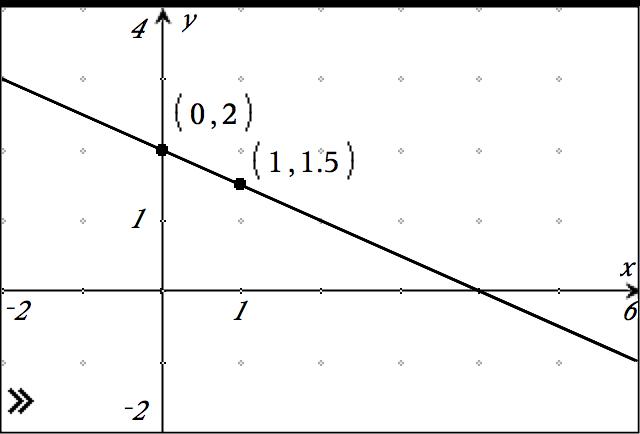My rational for discussing this lesson is that often students do not understand the significance of a line, and therefore they often depend on memorization of algorithms and formulas such as y = mx + b or y2 - y1 = m(x2 - x1). Or maybe they might forget what to do with an equation in general form
ax + by = c , Sometimes you get highly perplexed students when the equation is in this form ax + by - c = 0
I begin this lesson by discussing the basic premise of a line, the shortest distance between any two points. In order to graph any line, all we need is to plot two points and then we can take a straight edge and connect them. Once students understand this, then we no longer have to depend on formulas, "solving for y", "slope-intercept form", or "point-slope form".
Example: Graph the function 2x + 4y - 8 = 0
a) Let x = 0
2(0) + 4y - 8 = 0
y = 2 , so (0,2) is one point on the line
b) Let x = 1
2(1) + 4y - 8 = 0
y = 3/2 or y = 1.5 , so (1, 1.5) is another point on the line.
The job is now DONE!

This illustrates that there is never a need for slope-intercept form when graphing linear functions. The y-intercept is always evident as any point along the y-axis has an x-coordinate of "0", concurrently the slope can be identified by the simple understanding of rise over run. Its evident from the graph that its a negative slope down 0.5 and a run of 1, so the slope is -1/2 . Once students have an understanding of this, then they are ready to discover patterns that occur when the function is in slope-intercept form. Furthermore we can then break down and analyze other misconceptions that students have with graphing linear functions.
Surely there are more optimal points to choose than the ones chosen above, for example finding x & y intercepts and connecting them provides essential understandings and knowledge required for later lessons, additionally the students will be able observe the rise over run with little difficulty. Hence graphing linear functions by finding the x & y intercepts is discussed in a previous lesson to this with the same premise: All you need to do is find find two ordered-pairs and draw a line connecting them.
Check out the lesson progression and approach by viewing this video
You can download the powerpoint used in the video by clicking on the link below.
You can also download the student organizer/handout as a pdf by clicking on the link below